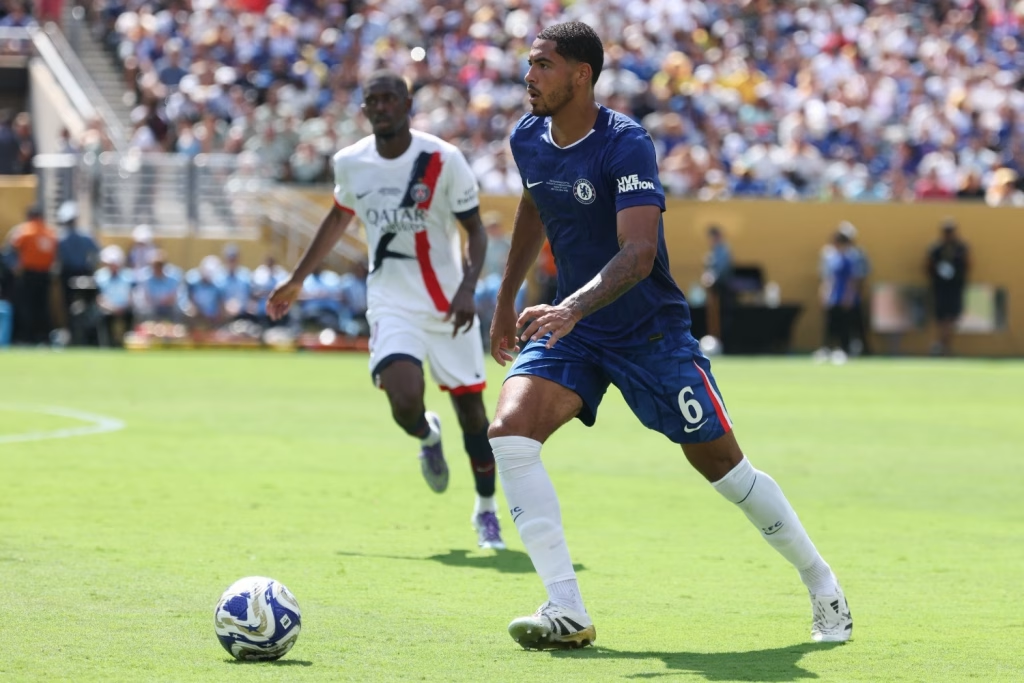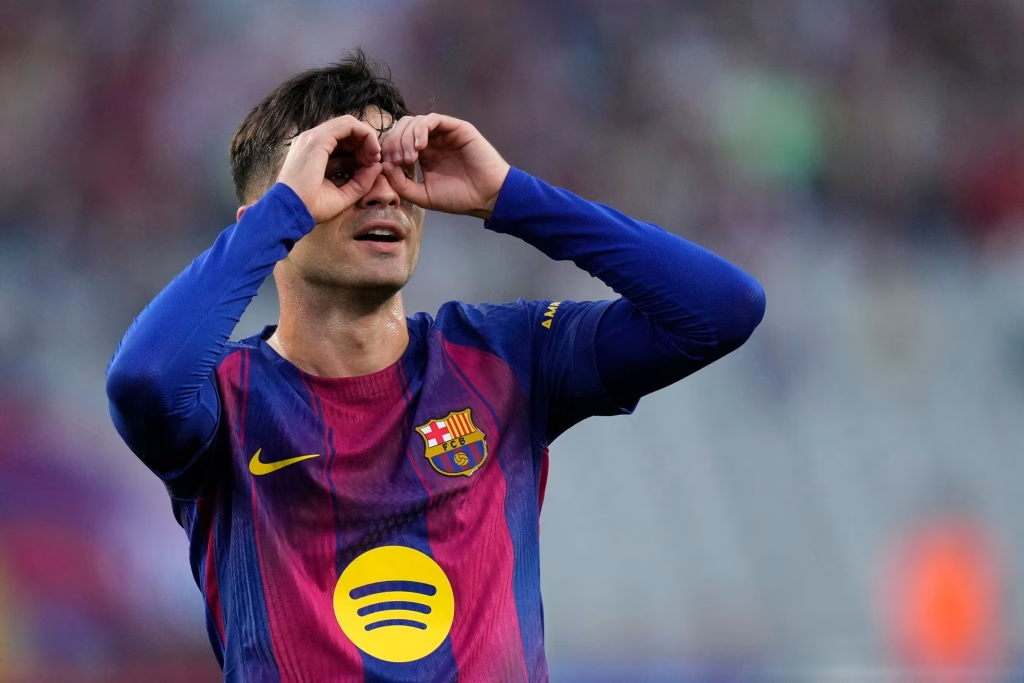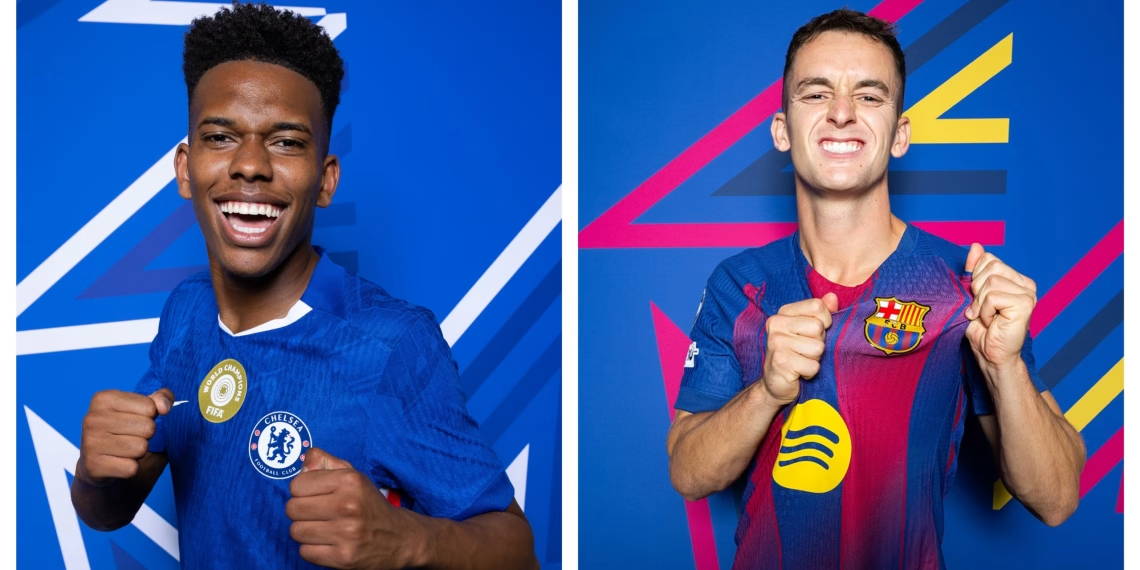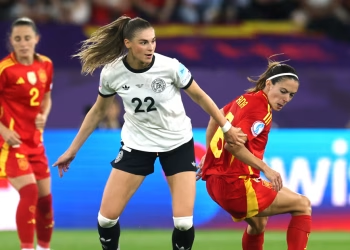The UEFA Champions League serves up a heavyweight collision on Tuesday night as Chelsea host FC Barcelona at Stamford Bridge—a fixture dripping with European pedigree and fiery history. The ghosts of Didier Drogba’s “disgrace” rant still linger, but this encounter presents fresh tactical intrigue: Enzo Maresca’s possession-oriented Chelsea against Hansi Flick’s high-octane Barcelona.
Both managers bring contrasting philosophies to this group stage showdown. Maresca preaches structured control through positional superiority and intelligent build-up play, while Flick demands relentless verticality underpinned by a non-negotiable high defensive line. The collision of these tactical doctrines could produce either a masterclass in modern football or expose critical vulnerabilities on both sides.
The margins between triumph and vulnerability are razor-thin. What unfolds could be a showcase of modern positional play versus relentless verticality, where tactical acuity and individual brilliance determine the victor.
This preview dissects formations, key battles, injury concerns, and potential match-winners before delivering a bold prediction for what promises to be a captivating European night.
Table of Contents
Formation Battle: Adaptability Meets Intensity
Chelsea’s Shape-Shifting System
Maresca deploys a nominal 4-2-3-1 that transforms fluidly into a 3-2-4-1 or 3-4-3 in possession. This tactical chameleon—think of it as a chameleon in blue, shifting shapes to exploit weaknesses—adapts to exploit opposition vulnerabilities while maintaining defensive balance. Out of possession, Chelsea compress into a compact 4-4-2 for hybrid pressing or a 4-2-3-1 mid-block.

This fluidity is Maresca’s calling card, allowing his side to adapt without losing control. The system’s genius lies in its transformative nature: right-back Reece James (if fit) or Malo Gusto drops into a back three during build-up, providing stability while Marc Cucurella inverts from left-back into midfield, creating overloads alongside Moisés Caicedo and Enzo Fernández.
Cucurella’s role deserves special attention—the linchpin inverts into midfield to form a double pivot, creating overloads, but his “theoretical striker role” allows him to surge into half-spaces, demanding versatility to disrupt Barcelona’s structure. This unconventional positioning adds unpredictability that conventional systems cannot match.
| Position | Expected Starter | Tactical Role & Rationale |
|---|---|---|
| Goalkeeper | Robert Sánchez | Integral to build-up, forming a 1-3-2 or 4-2 structure early on. His distribution sets the tone for bypassing pressure. |
| Right Back | Reece James (if fit) / Malo Gusto | Drops into a back three in possession, providing defensive solidity while enabling central progression. Maresca needs a reliable option here to maintain balance against Barcelona’s wide threats like Raphinha. |
| Centre Back (Right) | Tosin Adarabioyo | Offers height, physicality, and composure on the ball—key for Maresca’s control-oriented philosophy, especially against Lewandowski’s aerial prowess. |
| Centre Back (Left) | Trevoh Chalobah (or Benoît Badiashile) | Partners Adarabioyo for defensive resilience. |
| Left Back | Marc Cucurella | The linchpin: inverts into midfield to form a double pivot, creating overloads. His “theoretical striker role” allows him to surge into half-spaces, demanding versatility to disrupt Barcelona’s structure. |
| Defensive Midfielder (Right) | Moisés Caicedo | The anchor in the 3-1-3-3 attacking shape; must exploit spaces created by teammates dropping deep, turning defence into attack with smart first touches. |
| Defensive Midfielder (Left) | Enzo Fernández | Drops to drag markers, opening gaps for progression. His positional intelligence is vital for Maresca’s vertical purpose in build-up. |
| Right Attacking Midfielder | Pedro Neto | Maintains width, pins fullbacks, and tracks back—chosen for big-game work rate, stretching Barcelona’s high line. |
| Central Attacking Midfielder | João Pedro | Steps in for the absent Cole Palmer; links play, makes counter-movements to attack behind lines, and occupies central channels. |
| Left Attacking Midfielder | Alejandro Garnacho | Inside forward profile suits transitional play; his speed exploits spaces behind Barcelona’s defense. |
| Striker | Liam Delap (or João Pedro alternative) | Provides physicality and movement to draw defenders, creating chaos for runners like Palmer’s replacement. |
Barcelona’s Vertical Machine
Barcelona, meanwhile, favour an asymmetric 4-2-3-1 that can shift to a 4-3-3 for width, emphasising verticality and a non-negotiable high line. In possession, they push fullbacks high; out of possession, the synchronised “step up” press aims to suffocate build-up.

Flick’s setup is like a coiled spring: intense pressure releasing into rapid transitions. The system demands perfect synchronization—when the high line steps up in unison, it’s devastating. When timing falters, catastrophic space opens behind.
| Position | Expected Starter | Tactical Function & Rationale |
|---|---|---|
| Goalkeeper | Joan García | A “wall in goal,” restoring confidence with safe handling; crucial for avoiding the high press from the back. |
| Right Back | Jules Koundé | Stability against Chelsea’s left-side threats; must time the offside trap impeccably. |
| Centre Back (Right) | Ronald Araujo | Physical enforcer for aerial duels and covering spaces behind the high line. |
| Centre Back (Left) | Pau Cubarsí | Reads space brilliantly; key to maintaining the offside trap against Chelsea’s quick attackers. Key figure in build-up. |
| Left Back | Alejandro Balde | Provides attacking depth but must be covered—his high positioning creates vulnerabilities Flick mitigates with winger tracking. |
| Defensive Midfielder (Right) | Frenkie de Jong | Pivot for tempo; drops as a temporary líbero to cover flanks, essential for defensive solidity. |
| Defensive Midfielder (Left) | Pedri (or Marc Casado) | Metronome for control, though fitness concerns linger; dictates progression against Chelsea’s man-to-man midfield. |
| Right Attacking Midfielder | Lamine Yamal | Amplitude and skill to draw defenders, freeing space for runners like Fermín López. |
| Central Attacking Midfielder | Fermín López | Rhythm breaker; relentless runs into “indefensible space” test Chelsea’s pivot. |
| Left Attacking Midfielder | Raphinha (or Marcus Rashford) | Directness and crosses for Lewandowski; must sacrifice defensively to cover Balde. |
| Striker | Robert Lewandowski | Pins centre-backs, creates space; his movement without the ball is the key to unlocking deep blocks. |
Injury Crisis Reshapes Tactical Approaches
Chelsea’s Creative Void and Build-Up Concerns
Cole Palmer’s absence represents Chelsea’s most significant blow. The English playmaker fractured his toe in a home accident—a non-serious but devastatingly timed injury that robs Maresca of his chief orchestrator in half-spaces and final-third combinations. Palmer’s usual talismanic presence in the right half-space (dropping then bursting behind) cannot be easily replicated.
João Pedro must step into Palmer’s creative role, linking play and executing crossing movements with striker Liam Delap to disorganize markers and create chaos. The midfield pivot’s intelligence becomes even more critical to compensate for lost creativity, with greater reliance on their ability to exploit progression spaces.

Levi Colwill’s ACL injury compounds Chelsea’s problems significantly. His absence and Chelsea’s inability to compensate for it could pose a massive issue in the build-up phase against Barcelona’s intensity. Without Colwill’s build-up prowess from center-back—a vital component when playing out against high-pressing opponents—Chelsea may struggle to properly impose themselves on the game and execute Maresca’s possession-based system effectively.
Benoît Badiashile’s return to training bolsters options with his ball-playing ability, fitting perfectly for Maresca’s system. Romeo Lavia remains out, limiting midfield rotation options. These gaps force increased reliance on João Pedro’s versatility and the midfield pivot’s intelligence to compensate for lost creativity and build-up quality.
Barcelona’s Timely Boost with Midfield Question Marks
Barcelona, plagued by injuries earlier in the season, see a timely boost: Robert Lewandowski, Lamine Yamal, Marcus Rashford, Raphinha, Joan García, and Fermín López are all healthy, aligning their core for Flick’s vertical philosophy perfectly. This represents a remarkable turnaround from earlier struggles.
However, midfield is still a concern. Pedri, the playmaking metronome, is far from peak rhythm, potentially disrupting tempo as he may or may not be ready to face the Blues. Without Pedri at full fitness, Barcelona could still be at a disadvantage against Chelsea’s man-to-man midfield pressing.

This prompts the question of the third midfielder alongside the Dutchman Frenkie de Jong and, more than likely, Fermín as the number 10. Marc Casado emerges as the potential alternative if Pedri cannot start. These midfield fitness issues demand greater defensive sacrifice from wide forwards, turning individual fitness into tactical imperatives. Raphinha’s availability provides more defensive responsibility than Rashford, potentially solving this concern.
Maresca’s Tactical Philosophy: Controlled Chaos
Build-Up Brilliance and Attacking Overloads
Enzo Maresca’s Chelsea are a testament to positional play’s evolution—a system rooted in control, adaptability, and intelligence, influenced by the likes of Pep Guardiola but tailored to Stamford Bridge’s demands. It’s not about sterile possession; it’s purposeful, always eyeing verticality. The goal is simple in theory: balance offensive fluidity with defensive solidity, turning potential chaos into orchestrated dominance.
Chelsea’s build-up phase is a mix of fluidity and overloads, starting from the nominal 4-2-3-1 but transforming seamlessly into a 3-2-4-1 or 3-4-3. The right-back drops to form a back three, providing a stable base, while Cucurella inverts into midfield. This inversion creates a double pivot alongside the holding midfielder (Caicedo), generating central overloads that outnumber opponents in key zones.
It’s not random; it’s calculated to achieve numerical superiority, like a 3v2 or 2v1, ensuring stability in early progression. Goalkeeper Robert Sánchez is no bystander—he’s a participant, forming a 1-3-2 or 4-2 structure in the first phase. Short passing sequences dominate, but always with vertical intent.
One of Chelsea’s hallmark moves sees Enzo Fernández drop deep, dragging an opposition marker (say, Barcelona’s Fermín López) out of position, carving a gaping hole between their midfield and backline. Caicedo then exploits it with a clever first touch, advancing into space. In an ideal scenario, this drag-and-exploit dynamic bypasses pressure, turning potential traps into launching pads.
Of course, this is where we must mention Colwill again. Without his build-up prowess, Chelsea might struggle to properly impose themselves on the game. This represents a significant vulnerability that Barcelona’s intense pressing could ruthlessly exploit.
As play progresses, the attack evolves into a 3-1-3-3 shape for advanced circulation, emphasising internal overloads and depth. Maresca learned early that suffocating opponents too high risks stagnation against low blocks, so Chelsea now circulates from deeper positions: patient, probing, forcing the opposition (like Barcelona’s high line) to step up and expose midfield spaces.
Wingers such as Pedro Neto or Alejandro Garnacho maintain width, stretching defences and pinning full-backs, while Cucurella surges into half-spaces or even channels between centre-backs in that “theoretical striker” role, adding unpredictability that confounds conventional defensive schemes.
Key players shine here: João Pedro, filling in for the absent Cole Palmer, executes crossing movements with the striker. Liam Delap is tasked with disorganising markers, creating chaos through physical presence and intelligent movement. Palmer’s usual talismanic presence in the right half-space (dropping then bursting behind) is missed, but Pedro’s linking and counter-movements aim to replicate it.
In the final third, the system floods the box: as play goes wide, three players attack immediately, forging constant overloads in dangerous areas. It’s vertical purpose incarnate—possession as a means, not an end, always hunting the “indefensible space” with rotational interplay.
This blueprint’s beauty lies in its adaptability: against a press-heavy side like Barcelona, these structures destabilise man-oriented schemes, turning Flick’s intensity against him. But it demands precision—one misplaced pass, and the omelette cracks, exposing Chelsea to devastating counter-attacks.
Defensive Resilience with Occasional Fragility
Maresca’s defensive ethos blends aggression with resilience: a hybrid pressing system that doesn’t chase shadows but guides them into traps. Out of possession, Chelsea shifts to a 4-4-2, intense and proactive, funnelling opponents toward the flanks where recovery is aggressive through duels. It’s like herding cats into a corner: wingers (Garnacho or Neto) cut passing lines to full-backs, while the midfield commits to man-to-man marking, slamming shut central channels.
If the high press fails—and against Barcelona’s intense and aggressive approach, it might—Chelsea retreat swiftly into a compact mid-block, either 4-4-2 or 4-2-3-1. This reduces spaces around the holding midfielders (Caicedo and Fernández), protecting the pivot while staying alert to step forward and force errors.
However, Chelsea’s defensive discipline has not always been a consistent aspect of Maresca’s tactics. At times, it feels like the block lacks that compactness and can crumble under immense pressure from the attacking opposition. And few teams in European football embody that attacking pressure better than Flick’s Barcelona, led by Yamal and the returning Raphinha. This represents a genuine concern for Chelsea’s defensive structure.
Still, key players anchor Chelsea’s defensive setups: Caicedo’s tenacity in duels, Cucurella’s positional smarts from his inverting role, and the centre-backs’ (Adarabioyo and Chalobah) height for set-piece defence provide solidity. Recent improvements under a specialist coach have made Chelsea lethal from dead balls: four goals from corners in their first three 2025/26 Premier League games prove their aerial dominance.
Against Barcelona’s defensive fragility (22 goals conceded in 17 matches), this could be decisive. Set pieces represent a genuine weapon where Chelsea can exploit systemic weaknesses. In essence, Maresca’s out-of-possession phase is vital: resilient yet opportunistic, ensuring Chelsea controls without the ball as much as with it. But their potential fragility under sustained pressure cannot be dismissed.
Flick’s Barcelona: Intensity Unleashed
Barcelona’s philosophy revolves around synchronized pressing and vertical transitions. The high defensive line represents non-negotiable doctrine—defenders step up in perfect unison, squeezing space and forcing opposition errors through collective commitment.
This system demands exceptional timing from the front four. Lewandowski, Raphinha or Rashford, and Fermín must coordinate pressing triggers flawlessly. When executed well, they force long balls or recoveries, fuelling vertical transitions that catch opponents disorganized. Fail, and acres open behind their back four, ripe for Garnacho’s pace or João Pedro’s runs to exploit ruthlessly.
Flick’s attacking approach prioritizes directness over elaboration. Frenkie de Jong acts as tempo controller and temporary libero when fullbacks push high, dropping to pair with Araujo and providing defensive cover for the aggressive positioning. Pedri, when fit, serves as the metronome for control, dictating progression against Chelsea’s man-to-man midfield.
Fermín López operates as the “rhythm breaker”—relentless runs into “indefensible space” test Chelsea’s pivot constantly. His recent fiery form, evidenced in the 4-0 routing of Athletic Club, makes him particularly dangerous for this fixture. Coordinated with Lewandowski pinning defenders and creating space, Fermín becomes a dagger aimed at Chelsea’s defensive heart.
The wide attackers create amplitude: Lamine Yamal’s skill and intelligence draw multiple defenders, freeing space for central runners. Raphinha (if fit) offers directness, crosses for Lewandowski, and crucially must sacrifice defensively to cover Balde’s high positioning. Rashford provides similar directness but with less defensive sacrifice—a tactical trade-off Flick must consider.
Lewandowski’s movement without the ball remains world-class, pinning centre-backs and creating space that supporting runners exploit. His positioning is key to unlocking deep blocks and creating the chaos from which Barcelona’s rhythm breakers thrive.
Critical Battlegrounds That Will Decide Victory
Chelsea’s Structured Build-Up Against Barcelona’s Synchronised High Press
This stands as the territorial battleground for this intense clash. Maresca’s setup, with Cucurella inverting and Fernández dropping to create 3v2 overloads, is engineered to shatter man-oriented pressures. Fernández’s marker-dragging opens corridors for Caicedo to surge into, bypassing Flick’s front line and establishing control.
We must return to the Colwill issue, which may make or break Chelsea’s first phase of build-up. Without his ability to play through pressure with composure and quality, Chelsea’s possession-based system faces its sternest test.
On the other hand, Barcelona’s “step up”—that razor-sharp, non-negotiable high line—demands perfect timing from Lewandowski, Rashford or Raphinha, and Fermín López. If executed well, they force long balls or recoveries, fuelling vertical transitions that exploit any Chelsea disorganization. Fail, and acres open behind their back four, ripe for Garnacho’s pace or Pedro’s runs to devastate.
For Chelsea, winning here means control and the ability to impose their game. For Barcelona, it’s the gateway to chaos exploitation and rapid transitions. This battle will likely determine territorial dominance throughout the match.
Targeting Half-Spaces: The Indefensible Space
The space between centre-back and full-back—the “indefensible zone”—will define penetration for both sides. Barcelona excels here through Fermín López, the rhythm breaker whose relentless runs attack chaos, coordinated perfectly with Lewandowski pinning defenders and Yamal drawing markers wide.
Considering Fermín’s fiery form, as evidenced in the 4-0 routing of Athletic Club, he may very well be the perfect man for the job. His ability to time runs into these spaces and arrive unmarked tests Chelsea’s pivot relentlessly. Caicedo must track diligently and intelligently, or Fermín becomes a dagger piercing Chelsea’s defensive structure.
Chelsea counters with similar rotations and movements. Cucurella driving centrally from his inverted position, João Pedro’s counter-movements drawing out Cubarsí or Araujo, freeing lanes for overloads like 2v1s in dangerous areas. The “theoretical striker” role Cucurella adopts creates particular confusion for conventional defensive schemes.
Both teams’ success depends on positional intelligence and timing. One misstep, one mistimed run or delayed tracking, and the space turns genuinely indefensible. This micro-battle within the larger tactical war could produce the game’s decisive moments.
Barcelona’s Flank Vulnerabilities
It’s no secret Barcelona still leave their flanks exposed, especially on the left in case Rashford doesn’t track back properly, which could offer Chelsea a prime exploit. When Balde steps high to support attacks or engage in pressing, a chasm opens between him and Cubarsí—Barcelona’s Achilles’ heel laid bare for Chelsea to attack.
Chelsea can pounce ruthlessly: Neto pins Balde wide with his positioning, Cucurella or Fernández surges into the gap that appears, creating 4v3 overloads in dangerous transition moments. This represents one of Chelsea’s clearest routes to goal.
So what can Flick do to avoid this vulnerability? The answer lies in Rashford’s or Raphinha’s increased defensive sacrifice—tracking back to cover spaces or coordinating with De Jong as temporary líbero, dropping to pair with Araujo when Balde advances. But if Rashford falters in his defensive duties, Chelsea’s verticality punishes mercilessly.
This battle underscores necessary sacrifice: Barcelona’s wide forwards must break eggs defensively and commit to covering, or their high line crumbles under Chelsea’s targeted exploitation. One big caveat here is that Rashford may not even start; instead, Raphinha, being finally fit and healthy, would offer significantly more defensive intensity. Just in time to patch up a sore spot for the Catalans—a tactical adjustment that could neutralize one of Chelsea’s primary attacking avenues.
Set Piece Danger: Chelsea’s Weapon Against Barcelona’s Weakness
Finally, set pieces loom as a genuine differentiator amid contrasting defensive solidities. Chelsea’s revamped dead-ball threat (four corner goals early in the 2025/26 season) exploits Barcelona’s defensive fragility perfectly (22 concessions in 17 games overall).
Barcelona’s offside traps often falter against quick attacking movements from set pieces, where synchronized stepping becomes difficult amid congested penalty areas. Chelsea’s specialist set-piece coach has transformed dead balls into genuine weapons, with specific routines designed to create aerial superiority.
Lewandowski versus Chelsea’s towering centre-backs (Adarabioyo and Chalobah) in aerial duels provides Barcelona some counter-threat, or Raphinha’s delivery quality creating danger. But Barcelona’s systemic disorganisation from set pieces risks decisiveness here—one well-worked corner routine could prove the difference.
For Chelsea, set pieces represent significant leverage—a route to goal that bypasses Barcelona’s midfield control entirely. For Barcelona, it’s a systemic challenge demanding maximum vigilance and better organization than shown throughout the season. The statistics suggest Chelsea hold a clear advantage in this specific aspect.
Individual duels amplify these tactical battlegrounds: Lewandowski pinning Adarabioyo and Chalobah, testing aerial prowess and physical dominance; Raphinha’s pace against Disasi or James, a battle of power versus recovery speed where defensive tracking proves key; Yamal’s intelligence and skill versus Cucurella’s feistiness and positioning, where drawing defenders creates space for others; Fermín versus Caicedo and Fernández, where relentless runs challenge midfield stability and discipline.
Ultimately, the game turns on synchronisation—Barcelona’s press versus Chelsea’s overloads provides the true test of tactical adaptability and execution under pressure. Chelsea’s Palmer absence hampers creativity significantly, but their press-resistance through structured overloads could expose Barcelona’s high-line risks ruthlessly.
Barcelona’s returning core (Lewandowski, Yamal, Raphinha, Fermín) adds clinical edge and multiple goal threats, but defensive gaps (22 goals conceded) invite punishment from Chelsea’s set-piece weaponry and transitional speed. It’s all primed for a genuine tactical spectacle at Stamford Bridge.
Final Remarks and Predictions
In this tactical chess match, Maresca’s fluid control meets Flick’s intense verticality head-on, with absences like Palmer and Colwill tilting scales toward Barcelona’s transitional threats and pressing advantages. Yet Chelsea’s set-piece edge and structural overloads could ruthlessly exploit Barcelona’s defensive vulnerabilities.
Summing up: expect a high-octane affair where build-up battles determine territorial control and half-space exploitation decides goal-scoring dominance. The team that better executes their tactical principles under pressure will emerge victorious from this captivating European encounter.
Both managers bring tactical sophistication, but different philosophies: Maresca’s chameleon-like adaptability versus Flick’s coiled-spring intensity. The margins are razor-thin, the stakes are high, and Stamford Bridge provides the perfect stage for this Champions League showdown.
Prediction: Barcelona edges it 3-2, punishing Chelsea’s build-up vulnerabilities without Colwill and exploiting turnovers through devastating vertical transitions, but conceding to Chelsea’s structural resilience, set-piece weaponry, and moments of individual quality. A thriller awaits.
FAQs
When is the Barcelona vs Chelsea UCL match?
The Champions League group stage match takes place on Tuesday night at Stamford Bridge, with the exact kick-off time to be confirmed by UEFA broadcasting schedules.
Who is missing for Chelsea against Barcelona?
Cole Palmer (fractured toe from home accident), Levi Colwill (ACL), and Romeo Lavia remain out, significantly impacting Chelsea’s creativity, build-up play, and midfield rotation options.
What is Barcelona’s main tactical weakness in this match?
Barcelona’s high defensive line and exposed left flank when Alejandro Balde pushes forward represent their primary vulnerability, compounded by having conceded 22 goals in 17 matches this season
How does Enzo Maresca’s tactical system work at Chelsea?
Maresca uses a fluid 4-2-3-1 that transforms into 3-2-4-1 in possession through Marc Cucurella’s inversion into midfield and positional rotations creating numerical overloads in key zones.
Which Barcelona players return from injury for this match?
Robert Lewandowski, Lamine Yamal, Marcus Rashford, Raphinha, Joan García, and Fermín López are all healthy and available, though Pedri’s fitness remains a concern for Hansi Flick’s midfield.








